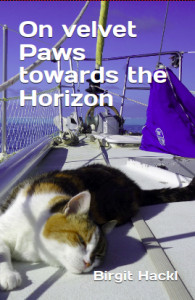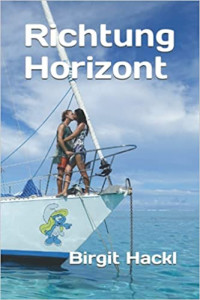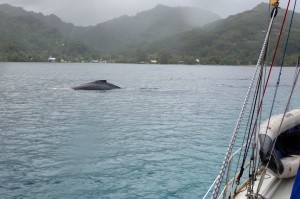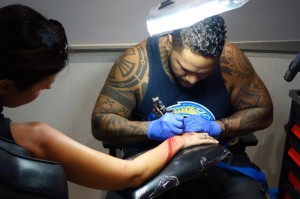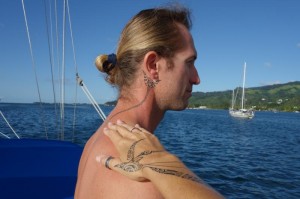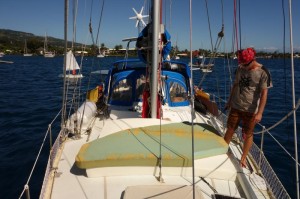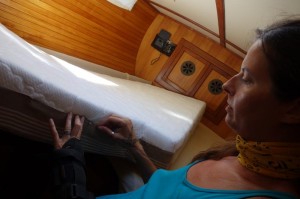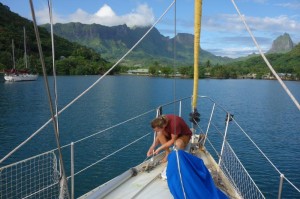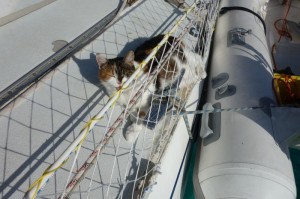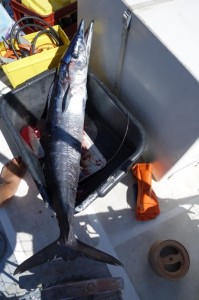From June to October humpback whales migrate to the tropics where the females give birth in the protected lagoons. We were lucky to see many of these impressive creatures from anchorages in Tahiti and even more here in Huahine. Yesterday a group of three whales (2 adults, 1 baby) came through the pass into the lagoon just off Fare and as we are anchored just on the edge of the sandy shelf next to the pass they swam past Pitufa within a few metres. There was quite some activity on the radio with crews from anchored boats alerting each other of the nature spectacle going on in our next vicinity. Everybody was watching awestruck from their decks despite a squall that arrived almost together with the whales, 2 dinghies buzzed towards them keeping a respectful distance to the giants. We couldn’t believe our eyes when a large catamaran with lots of crew steamed in through the pass and headed straight for the group of humpbacks without even slowing down. The whales dove out of sight immediately, but when they emerged again the cat went after them again and thus chased them out of the lagoon. For us it was incredible to watch such irresponsible behaviour as you’d expect at least some awareness from people cruising (or chartering) here.
2015
09
Sep
Whales!
2015
28
Aug
Exploring Huahine
We’ve been in Huahine for one and a half weeks and we really like it here. The pace of life is slow, only about 6000 islanders live in small villages around the twin islands Huahine Nui and Huahine Iti (big and small Huahine which are so close that they are connected by a short bridge), but the capital Fare is big enough to feature amenities like bike rental places, numerous roulottes (vans that have been turned into restaurants), a big supermarket, veggie stands with local produce and even a bar with a happy hour. There’s also a big medical centre, a dentist(!) and even a vet(!!!) on tiny Huahine. There are quite some tourists around, but most of them stay in little pensions, up to now we’ve only seen one bigger hotel with bungalows on the lagoon. There are more yachts around than we had expected, but it seems there are still puddle jumpers lingering here before heading further west and charter catamarans from Raiatea also hop over to nearby Huahine.
The first week we were anchored off the main town Fare and after the two months in Tahiti during which our only exercise was carrying shopping bags we took the opportunity of hiking to nearby temple sites (marae) and renting bikes (huffing and puffing). The anchorage on a sandy shelf between the two passes into the lagoon is pretty with turquoise water, but a constant outflowing current (because swell fills up the lagoon and the water then streams out through the passes) meant that Pitufa was always aligned with the current, even when the wind was blowing 25 knots from the side or stern, we were just swinging around then quickly being shoved back–not very comfy.
We then decided to find a more sheltered place and got the anchor up expecting a downwind sail in northeasterly winds southwards on the western coast. It seems that Huahine’s geography somehow funnels the wind over ridges though, so instead of calm conditions on the lee side we had violent gusts out of each bay and soon motored against gusts accelerated from the Southeast to up to 35 knots… Weird.
As the lagoon is generally deep with very shallow coral shelves the yacht-friendly Commune of Huahine has set mooring buoys (free use!) in several places. On the way South we checked some out, but they were exposed to strong gusts and again in a constant current. We finally found a rather sheltered spot in lovely Haapu bay off the little village. There is no current so Pitufa is properly facing into the wind again.
Mariela–the owner of the tiny magasin in Haapu–is very friendly, reserves a baguette for us each morning, offered to get us anything we need from Fare and even organised two bikes for us this morning. Unfortunately one of them broke down after a few kilometres, but Mariela played breakdown service and picked us up. Her next recommendation was a hike up the mountain ridge behind the village and she showed us the beginning of the trail, not without pointing out that she hadn’t been up there yet. Struggling up the incredibly steep and slippery path we soon understood why, but we crawled all the way up anyway and were rewarded with a great view from a rocky picnic spot ![]()
2015
16
Aug
Arrived in Huahine
The weather forecast predicted 11 to 16 knots of wind from the SE, which sounds brilliant, but then we had to motor the first 3 hours through confused seas to get out of Tahiti’s lee, then finally a breeze set in (hurrah, set the sails!), only to die down soon after. For hours the slapping genoa buffeted Pitufa with a melodic WA-WA-WHOOMM!, the fully battened main answered with a mast-shaking BAMM! and Pitufa’s crew suffered with her. Around midnight proper wind set in and pushed us through the still lumpy seas to our goal that we reached a bit delayed in the afternoon.
2015
15
Aug
… and go!
It’s only 100 nm from Papeete to Huahine, so we set out in the afternoon, to arrive tomorrow morning.
2015
13
Aug
On your mark, get set…
Finally we’ve got all our stuff together and can get ready to leave Papeete! After keeping us waiting for dinghy parts for 2 months (the rubber attachments of the mercury we bought here last year broke off after a few months and we wanted handles instead of the attached cord that had turned out to be far too weak to carry the dinghy) we got the handles we had wished for without further discussions about warranty or having to do the repairs in their shop (not very practical for cruisers to leave the dinghy there and then swim back to the boat…).
At the moment a front is passing over Tahiti, but it looks like we’ll have nice wind to sail to Huahine from tomorrow on ![]()
2015
07
Aug
Got our Polynesian Stamps
When the first explorers arrived on the Polynesian islands they were fascinated by the ‘paintings’ the locals had all over their bodies under the skin. The sailors soon got these body decorations too and the Polynesian word ‘tatau’ (or ‘tatu’ in the Marquesas) entered the European vocabulary as tattoo. The missionaries later discouraged tattoos (along with all other forms of traditional culture), but in the revival of the Polynesian culture during the last decades the old art of tatau also became popular again. Today almost all Polynesians here in Fr. Polyn. wear them proudly and after looking at this beautiful form of art for more than two years we could no longer resist and went to a popular tattoo studio here in Papeete.
Tagaloa Tattoo (check out www.tagaloatattoo.com) has a good reputation among the locals, lots of prizes from competitions decorate the walls, up to four artists work simultaneously on extensive tattoos in the traditional Tahitian and Marquesian style. We got appointments with Kalio (the boss) who asked about our lives, considered our suggested motives and then started drawing directly on the skin, altering the lines several times before adding the intricate symbols–including voyage, the sea, the sun, courage, strength, protection and loyalty. The actual needlework was then quickly done and we’re finally fully ‘papeetisised’ (that’s what boats are called here after importation…).
2015
05
Aug
Don Quijote in Tahiti
When we arrived more than two months ago in Tahiti we naively planned to get a few things done that need the infrastructure of the big city and to be off soon again. Since then we’ve been put off with delaying tactics and lame excuses. There’s a general unwillingness to take responsibility, blame others instead and of course the hope that a problem that’s ignored for long enough will disappear by itself. Whenever we have to depend on somebody else here we soon get a feeling of fighting windmills. The anchorage here in Taina has been windy and choppy for a few days–a bouncy Pitufa that keeps us from sleeping and extra splashy dinghy rides don’t help with the mood. Yesterday our mobile phone got drowned during such a dinghy ride, so we’re incommunicado for the time being.
On the positive side we’ve realised reading through the log that we’ve made steady progress on all the tasks that we can handle ourselves. While staying in Tahiti and Moorea we’ve repaired the anchor winch, found and repaired a leak in the kerosene tank, adjusted the main sail, repaired the deck light, mended the hatch covers, fixed a new railing netting, resewed part of the sprayhood, cleaned the sea strainer and the diesel filter, recut new matresses, filled up the diesel tank, bought and stored full provisioning for the next season for us and all spare parts we could think of for Pitufa, adjusted new terminals for the life lines by lathe, changed the impeller on the engine, installed new hoses for the freshwater system, got a new tap for the bathroom and redid the silcone in the bathroom–so our time here hasn’t been entirely wasted ![]()
2015
28
Jul
Just got a new mattress
When land-based people want a new mattress they just go to a shop and buy one. For cruisers like us, that’s just the first step. Then comes the explanation where the thing should be delivered to (what, you have no address, what do you mean, just come to the parking space of the yacht club?), to be repeated several times a few days later on the telephone with the astonished (lost) delivery guy (of course all in broken French).
As our bed is creatively shaped, a bit like a butterfly lying in the aft cabin with his head facing forward, we need to buy two queen sized mattresses and then cut them into shape (not to be recommended on deck on a windy day like we did). As the new mattresses are a bit higher than the old ones, we also had to alter the covers, which turned into a 3 day sewing machine project (the fact that I have my left arm in a splint to immobilise my cyst-ridden wrist for 4 weeks doesn’t help).
Step one: undo the seams of the upper part of the old cover and all seams on the new cover.
Step two: Cut the new piece according to the old part leaving a margin to make it a bit higher, sew the new upper piece onto the old cover.
Step three: Curse the crooked thing thoroughly, undo all seams and begin all over again.
Step four: Measure the new cover directly on the mattress, adjust the thing several times with pins, sew all corners (none of them at right angles) and curves by hand and then transfer it again to the sewing machine for another seam.
Step five: Celebrate, have a wonderful night on one half of the new bed and prepare mentally to repeat the whole process (minus step 2 and 3) with the second half ![]()
Good night and good luck!
2015
20
Jul
Plants overboard
We’ve been stuck in Tahiti since last week, struggling with delayed appointments, unfriendly staff at chandleries and a general feeling that the world’s not cooperating with our plans.
Somehow the herb garden under our spray hood got infected with lice and some strange, mould-like disease. My frantic efforts at cleaning the leaves and fighting the lice manually had not much effect, so with a very heavy heart I cut off a few healthy looking branches from the thai basil, the mint, the basil, the oregano and the spinach to layer, harvested everything else and dumped the plants and the soil into the sea feeling like a mother drowning her green babies.
In the evening we had Vietnamese spring rolls with handfulls of coriander, thai basil and mint wrapped in and there are still enough herbs in the fridge for a curry and pasta week.
At least we can get fresh soil from the hardware store here, the pots are thoroughly cleaned and I hope that I’ll be able to start a new garden with the saplings I’ve saved and new seeds.
2015
12
Jul
New railing netting
The last couple of days, in-between the hiking trips with more and less luck (we still have not found the track from Paopao to Vaiare…), we replaced the netting of the railing around Pitufa. Sounds easier than it actually was–in total we spent 3 full working days cutting, attaching, stretching, swearing, undoing, reattaching and tightening the bloody thing.
The old one had started to disintegrate after being exposed to the elements for more than 7 years. The new one covers only the lower half (from the middle lifeline down to the toe rail) which looks more elegant than the old full-height solution. Also, we often had to reattach the old one onto the upper lifeline due to chafing (e.g., from sheets), so this should no longer happen with the lower-half solution. Of course, there is a higher chance of loosing hats and laundry now, but it is still high enough to keep our ships cat Leeloo from slipping over board. Leeloo was suprisingly disinterested in the actual process of replacing her net, but as soon as it was finished she checked it by vigurously bumping her head into it and declared it Leeloo-safety-approved.
2015
08
Jul
Operation pathfinder
Last year we did lots of hiking in Moorea and usually found our way (even though sometimes in circles) to our destination (or at least A destination) despite the fact that most paths have no signs (we suspected that tour guides with entrepreneurial spirit removed them to support their business…). The two hikes last week to the waterfalls on the eastern side were also simple to find, so we were optimistic when we set out towards Vaiare from Cook’s Bay to find a track over the mountain ridge. We were confident enough to take a young American couple from the neighbouring boat with us, but we couldn’t find the beginning of the track on the outskirts of the village, got confusing info whenever we asked for directions, then someone mentioned that there was hunting going on in that area and we heard more and more shots. We didn’t want to accidentally end up on a local BBQ (imagine what ridiculous inscription that would make on a tombstone: “mistaken for a pig in Polynesia”), so we changed plans and hiked into the other direction towards Opunohu Bay and up to the Three Pines Lookout that we’d been to before (even though the path from this side was quite hidden and a local walked a bit with us keep from going astray).
Yesterday we moved from the reef anchorage just at the outside of Cook’s Bay to the interior of the bay where we’re now anchored amidst a fleet of Puddle Jumpers (boats that sail from America to New Zealand/Australia in one season). It’s funny to hear American voices instead of the French we’ve got used to. For most of them their 3 months allowance in Fr. Polynesia is coming to an end while we lucky Europeans can stay for 3 years (afterwards import tax on the boat would be due) ![]()
2015
05
Jul
Wahoooooo
After a series of fare-well dinners and drinks with Liesbet from Irie, we motored from Vaiare to Cooks Bay on the northern coast of Moorea on Thursday. On the way we caught a giant wahoo, so we’ll have fish for breakfast, lunch and dinner for the next couple of days (in addition to some pressure-cooked jars for some time later). Don’t worry, we’re having a different dish every time (thanks to Birgit’s cooking creativity).
2015
30
Jun
When to go where in French Polynesia
French Polynesia is a wide-spread and diverse cruising area. To make most of the different archipelagos it is essential to pick the right time. We’ve put together info on when to go where in French Polynesia here.
2015
29
Jun
Pleasant boat routine
We have finally settled back into the pleasant daily routine of boat life in a quiet anchorage. The Tahitian winter weather with hot sun, but crisp air is quite invigorating and we use our high level of energy to get jobs on the boat done and to explore beautiful Moorea.
In the past few days we’ve reinstalled the deck light, made some adjustments to our mainsail (more sliders), cleaned the bottom, repaired a tiny leak in the kerosene tank (it kept losing pressure), and mended the elderly covers of our hatches. We also got our trekking sandals out and walked to three beautiful waterfalls in the vicinity. Yesterday we attempted to hike up Mt. Mouaputa, an impressive peak with a little peep hole at the very top that we’ve been admiring from down in the lagoon. The trail led steeply up through dense jungle vegetation, and we had to climb over and under branches and enormous, winding roots and stumbled over the slippery rocks when the path led up a creek. We were hoping to make it up to the ridge to get at least a glimpse of the view over the lagoon, but after 3 hours we gave up, had our picnic without a view, but in the middle of a beautiful, lush rain forest and slithered back down to the valley.
2015
27
Jun
Catamaran for sale in Moorea (Tahiti’s sister island)
Our friends Liesbet and Mark have decided to quit cruising and their catamaran is waiting for buyers here in the little marina of Vaiare. We’ve met Liesbet here (Mark’s already in the US) who has the sad task of selling/giving away all their personal things that won’t fit into the airplane luggage (23 kg is quite a painful limit…).
If you always wanted to cruise the magical islands of the South Pacific, but were reluctant to sail the first tough island-free leg over the Pacific between Galapagos and French Polyesia (3 weeks on the ocean), their catamaran Irie may be your chance to start off right in the middle of the South Seas! Take a look at www.itsirie.com to see details.


